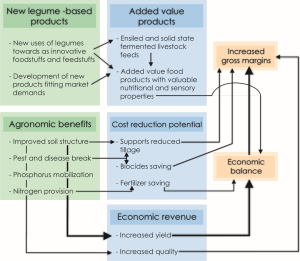Grain legumes cultivation provide multiple environmental and economic benefits, increasing resources efficiency and contributing to balance the European deficit in plant protein production. In this issue, the project EUROLEGUME “Enhancing of legumes growing in Europe through sustainable cropping for protein supply for food and feed” (EUROLEGUME) project started in January 2014, in line with the strategy of reaching new alternatives to enhance the competitiveness of the agro-food sector, started in January 2014. It is aimed to enhancing the currently exploited genetic resources of legumes traditionally grown in Europe (pea, faba bean, and cowpea), identifying new inoculants (rhizobia and arbuscular mychorrizal fungi (AMF), and crops management alternatives under conventional and organic systems. In addition, the project envisaged the development of new foods and feeds and the design of new applications of the vegetative material as green fertilizers as an initiative to reduce the environmental impact of agriculture in Europe.
Since future competitiveness of grain legumes in Europe will depend on agronomic and scientific developments, under the coordination of the University of Trás-os-Montes and Alto Douro (Vila Real, Portugal), EUROLEGUME involves 18 partners from 10 countries (Albania, Austria, Czech Republic, Estonia, Greece, Latvia, Norway, Portugal, Sweden, and Spain), including 12 academic/scientific institutions and 6 SMEs focused on these areas. This distribution contributes to understand the purpose of transferring knowledge towards the added-value chain.
Enhancing genetic resources and fine-tuning of agronomical practices

(http://faostat.fao.org/, 2016)
In the EU-28, in 2015, dry pulses were grown on 1.3 MHa, whilst their production reached 3.2 MTonnes. However, the production of dry pulses differed significantly between Member States, as well as the productivity of these crops (Fig. 1). The highest productivity rate corresponded to Denmark, France, Germany, Ireland, Montenegro, Poland, and Sweden (3.4 Tonnes/Ha, on average), which contrast with the average production in the additional countries dedicating substantial resources to these crops (1.9 Tonnes/Ha, on average).
This situation evidences the scope for improving the efficiency of pulse crops in Europe, by detecting the most adequate genotypes to be grown in the different countries and the proper crops management, regarding the identification of the optimal inoculant/s combination to be applied in the diverse agro-climatic conditions and farming systems (conventional, organic, crops rotations, etc.). Thus, EUROLEGUME is contributing to the resources available by gathering and evaluating the most significant phenological and productive traits of a significant genepool of pea, faba bean, and cowpea (196, 176, and 71, respectively), which will allow to identify the best varieties. From this initial pool, in the halfway of the project, it has been already identified 21 candidates of pea, 19 of faba bean, and 15 of cowpea, according to their growth habits, yield, and nutritional composition. At the same time, the genepool gathered is being evaluated on the molecular characteristics, in order to identify, resorting to multivariate analyses, those genes responsible for the most interesting characteristics, and thus candidates to be included in further breeding programs.
During the project, rhizobial and AMF strains were also isolated from locations with distinct history of legumes cultures, which will allow, after molecular characterization and evaluation of the biological nitrogen fixation (BNF) capacity, to inform on molecular markers, useful for field studies and the most efficient strains on BNF under the wide range of agro-climatic conditions. Also, towards a more pragmatism, this information will contribute to the development of new commercial products skilled to increase significantly BNF, as well as legumes yield and nutritional properties.
From the advantages derived of the optimization of the agricultural management concerning legumes, their contribution to subsequent crops in rotation cropping systems is also considered by EUROLEGUME (Fig. 2), which is of special relevance in organic farming systems. This issues will be addressed under different agro-climatic conditions that will enable, informed decisions on the best agricultural management to reach environmental benefits and increasing the sustainability of European farming.
Challenges for innovative uses of pulses and legume by-products

The increase of the world population, associated with today’s lifestyle, calls into question whether agriculture can meet the food requirements of humanity. Hence, European authorities are fostering the identification of new and diversified uses for legumes towards a sustainable food chain, by replacing animal proteins by those of vegetable origin. In this context, the nutritional properties of legumes for human and animal diets make them an interesting choice, featured by low inputs requirements. In addition, legumes could benefit from a demand for products with pleasant, healthy, and natural properties.
In connection with this new trend, EUROLEGUME’s partners are deeply focused on the development of a wide panel of new ready to eat legume-foods products, some of them almost ready for retail, by using varieties displaying interesting nutritional and sensorial characteristics. This approach will help to obtain new products fitting the market niche created for healthy foods as well as new processing and packaging alternatives.
Mutual benefits of transferring knowledge on legumes from science to the market
Food industries are continuously seeking for new products fitting the consumers demand and contributing to a significant innovation regarding products and processing alternatives. At the economic level the mutual interaction within the agro-food sector between scientists and stakeholders, will contribute to identify business opportunities and to reduce costs as well as to develop coordinated actions and to guarantee products quality. In order to properly develop the essential collaboration between them, the project involves the participation of 6 SMEs with actively work in developing new products. The consortium accounts with an ambitious dissemination program responsible for the management of activities addressed to transfer non-confidential information and knowledge to farmers, producers, and consumers, throughout the preparation of dissemination documents and the development of field-days, seminaries, and workshops, which in the halfway of the project have allowed the active participation of several companies.
Acknowledgements
European Project EUROLEGUME (Seventh Research Framework Programme of the European Union – FP7 research project n∘ 613781).
Text by Raúl Domínguez-Perles, Ana Barros, and Eduardo Rosa | UTAD-CITAB – University of Trás-os-Montes e Alto Douro and Centre for the Research and Technology in Agro-Environmental and Biological Sciences.


